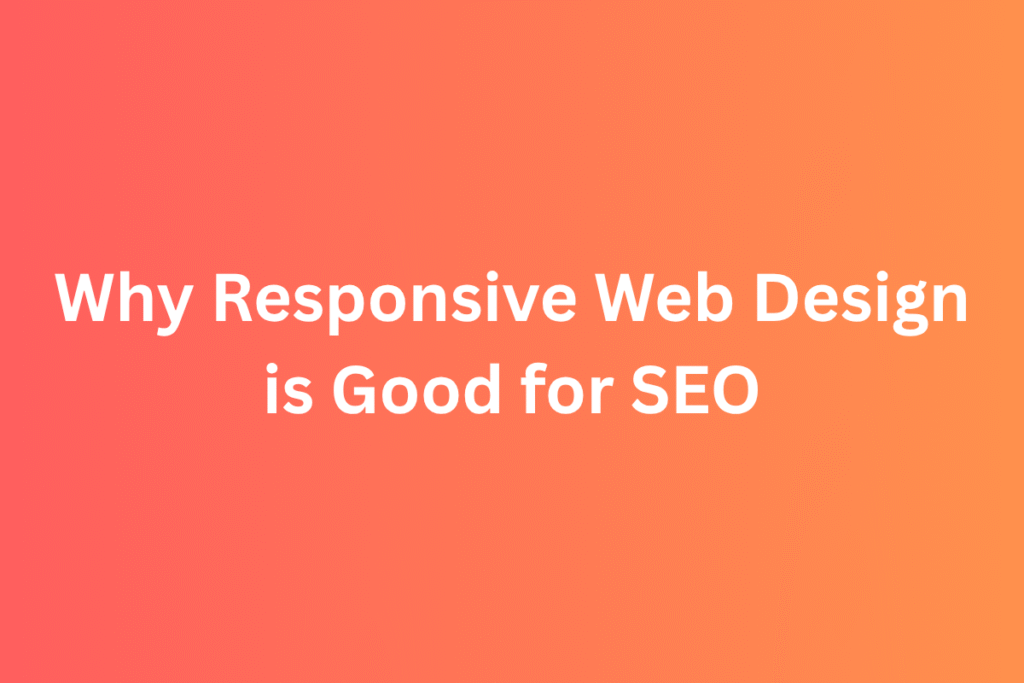When we talk about SEO, people usually think of keywords, backlinks, content, and page speed. But there’s another important factor that quietly plays a big role in how your website ranks on Google: responsive web design.
If you’re serious about growing your website traffic, improving user experience, and staying ahead in search rankings, you can’t ignore responsive design. In this guide, I’ll explain why responsive web design is good for SEO in a simple and friendly way.
What is Responsive Web Design?
Let’s keep it very simple.
Responsive web design means your website automatically adjusts itself based on the device people are using. Whether someone opens your site on a mobile phone, tablet, laptop, or big desktop screen, the website will fit perfectly, without users having to zoom in or scroll sideways.
In short:
- One website
- Multiple screen sizes
- Always looks good
Popular platforms like WordPress, Shopify, BigCommerce, and Wix all offer responsive themes because it’s now a basic requirement.
Why Google Loves Responsive Websites
Now, let’s get into why responsive web design is so good for SEO:
1. Google Uses Mobile-First Indexing
Since 2019, Google has officially moved to mobile-first indexing. This means Google looks at your website’s mobile version first when deciding where you should rank.
If your site isn’t mobile-friendly, you’re already at a disadvantage.
A responsive website automatically gives Google the mobile experience it wants to see.
2. Better User Experience (UX)
Google wants to show search results that people find useful and easy to use. If users come to your site and struggle to read text, click buttons, or navigate, they will leave quickly. This increases your bounce rate and signals to Google that your site isn’t helpful.
Responsive design keeps users happy because:
- Text is readable.
- Images are properly sized.
- Buttons are easy to tap.
- Pages load smoothly.
Happy visitors = Lower bounce rate = Better SEO signals.
3. Faster Page Load Speed
A good responsive design often leads to faster load times on mobile devices. Page speed is a confirmed ranking factor for SEO.
When you use one responsive version of your website (instead of a separate mobile version), you avoid extra redirects and unnecessary scripts that slow down your site.
4. Avoids Duplicate Content Issues
In the past, many websites created separate mobile versions with URLs like “m.example.com”. This often caused duplicate content issues if not handled properly.
With responsive design:
- You have one URL for every page.
- All link equity goes to one URL.
- No need for complicated canonical tags.
This makes life easier for both you and Google.
5. Easier Website Management
Managing two versions of your website (desktop and mobile) takes more work, more time, and more risk of SEO errors.
With responsive design:
- You manage only one site.
- SEO changes apply across all devices automatically.
- Updates are faster and easier.
Less headache = More time to focus on growing your business.
6. Higher Social Sharing and Engagement
Many people share links directly from their mobile devices. If your site isn’t responsive, people may click shared links and land on a broken or messy version of your site.
Responsive design ensures that shared links always load correctly, no matter where they are opened. This helps you get better engagement from social traffic, which indirectly supports your SEO efforts.
7. Lower Bounce Rates and Longer Dwell Time
When people land on a website that looks good and functions well on their device, they stay longer. They read more pages, explore products, or read your blog articles.
Google sees this behavior as a positive signal. Longer dwell time and lower bounce rates show Google that people are finding value on your website.
8. Higher Conversion Rates
SEO isn’t only about rankings. It’s about turning traffic into leads, sales, or subscribers.
A responsive website helps visitors easily:
- Fill out forms
- Make purchases
- Contact you
- Subscribe to your email list
Better conversion rates mean better ROI from your SEO efforts.
9. Voice Search Optimization
With more people using voice assistants (like Siri, Alexa, and Google Assistant), mobile-friendly, fast-loading, and well-structured websites tend to perform better in voice search results. A responsive design naturally supports voice SEO because it focuses on mobile usability.
10. Google Officially Recommends Responsive Design
This is the biggest proof.
Google has clearly stated that responsive design is their recommended mobile configuration. If Google itself says so, you know it’s the safest and most SEO-friendly route.
Quick Real-Life Example
One of my clients at PratsDigital had a beautiful desktop website but a poor mobile version. After switching to a fully responsive design:
- Their bounce rate dropped by 32%
- Average session duration increased
- Organic rankings improved within 3 months
- Conversion rates jumped by nearly 20%
It’s not magic—it’s just better design aligned with how users browse today.
Responsive Design vs Mobile Version: Which is Better for SEO?
Many people still ask: Should I build a separate mobile version or go responsive?
The simple answer: Always go responsive.
| Feature | Responsive Design | Separate Mobile Site |
|---|---|---|
| SEO-Friendly | Yes | Risky |
| Easier to Manage | Yes | No |
| One URL | Yes | No |
| Consistent User Experience | Yes | Often No |
| Google Recommended | Yes | No |
How to Make Your Website Responsive
If your website isn’t responsive yet, here are simple steps you can take:
- Choose a Responsive Theme
- Most website builders offer responsive templates.
- Avoid outdated themes that aren’t mobile-friendly.
- Use Mobile-First Design Approach
- Design for mobile devices first, then scale up for larger screens.
- Test Your Site on Multiple Devices
- Use tools like Google’s Mobile-Friendly Test.
- Manually check your site on phones, tablets, and desktops.
- Hire a Professional (if needed)
- At PratsDigital, we often help clients redesign their websites to make them responsive and SEO-optimized at the same time.
Common Mistakes to Avoid
While working with many websites, I often see some common responsive design mistakes that can hurt SEO:
- Using too-small fonts on mobile.
- Buttons that are hard to click with fingers.
- Images that don’t scale properly.
- Pop-ups that block content on mobile screens.
- Slow load times due to heavy scripts.
Fixing these issues can instantly improve both UX and SEO.
The Future of SEO is Mobile and User Experience
Search engines are getting smarter. They care more about how real users experience your website. Responsive design directly supports:
- Core Web Vitals
- Mobile usability
- User satisfaction
In short, responsive web design isn’t just good for SEO — it’s becoming essential.
Conclusion
If you want your website to rank higher, keep visitors happy, and convert better, responsive web design should be at the core of your SEO strategy.
Remember:
- Google loves it.
- Users love it.
- Your business benefits from it.
At PratsDigital, we always advise businesses to invest in responsive design because it supports both short-term SEO gains and long-term business growth.
Need help making your website responsive and SEO-friendly? Feel free to contact me at PratsDigital. Let’s grow your business together!
Discover more from PratsDigital
Subscribe to get the latest posts sent to your email.


